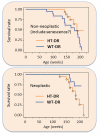Dietary restriction and aging in rodents: a current view on its molecular mechanisms
- PMID: 22396859
- PMCID: PMC3295025
Dietary restriction and aging in rodents: a current view on its molecular mechanisms
Abstract
Dietary restriction (DR) is a robust non-genetic intervention that reduces morbidity and mortality in a range of organisms. This suggests the presence of an evolutionary-conserved pathway that regulates aging and lifespan in response to reduced food or energy intake. Recent genetic analyses have shown that single gene mutations could extend the lifespan, even in mammals. Many longevity genes are clustered into nutrient-sensing and metabolic adaptation pathways, which are also thought to be involved in the effect of DR. The responses of these mutant animals to DR in terms of lifespan or other aging phenotypes suggest that proteins encoded by these genes are involved in the effects of DR. This review focuses on the roles of fork head box O (FoxO) transcription factors, AMP-activated protein kinase (AMPK), and sirtuins (particularly SIRT1) in the effects of DR in rodents. FoxO transcription factors are mammalian orthologs of DAF-16, which is required for the lifespan extending effects of reduced insulin-like signaling in nematodes. A recent study in rodents suggested that FoxO1 is involved in the anti-neoplastic effects of DR. Although aak2 in nematodes (mammalian AMPK), Sir2 in yeast and Sir2.1 in nematodes (mammalian SIRT1) were also reported to be essential for lifespan extension by DR, the findings are thought to depend on the genetic backgrounds of the organisms and/or methods used to induce DR. In rodents, AMPK and SIRT1 are implicated in the metabolic regulation by long-term DR. Genetic and molecular dissection of the mechanisms underlying the effects of DR will provide us with knowledge of the basic aging processes, as well as insights into the development of DR mimetics, to extend the healthy lifespan in humans.
Keywords: AMPK; Dietary restriction; FoxO1; Rodents; SIRT1.
Figures




References
-
- Masoro EJ. Subfield history: caloric restriction, slowing aging, and extending life. Sci Aging Knowledge Environ. 2003;2003:RE2. - PubMed
-
- Min K-J, Tatar M. Restriction of amino acids extends lifespan in Drosophila melanogaster. Mech Ageing Dev. 2006;127:643–646. - PubMed
-
- McCay CM, Crowell MF, Maynard LA. The effect of retarded growth upon the length of life span and upon the ultimate body size. 1935. Nutrition. 1989;5:155–171. 172. discussion. - PubMed
-
- Harman D. Aging: a theory based on free radical and radiation chemistry. J Geronto. 1956;11:298–300. - PubMed
LinkOut - more resources
Full Text Sources
Research Materials
Miscellaneous
